Giving Credit Where Credit is Due: Bats are Crucial to a Healthy Forest
Let me introduce you to the coolest mammalian order – Chiroptera, also known as bats. Why do I think bats are so cool? They’re remarkably diverse, with almost 1500 species worldwide that eat everything from beetles to blood, moths to mangoes, and spiders to songbirds. Especially in the tropical parts of the world, bats show incredible variation in form and function, with cryptic coloration, wrinkly faces, projections from their noses to aid in echolocation, sucker pads for hanging onto leaves, and more. Indiana is a regular home to ten of these animals, all nighttime predators of insects and spiders. 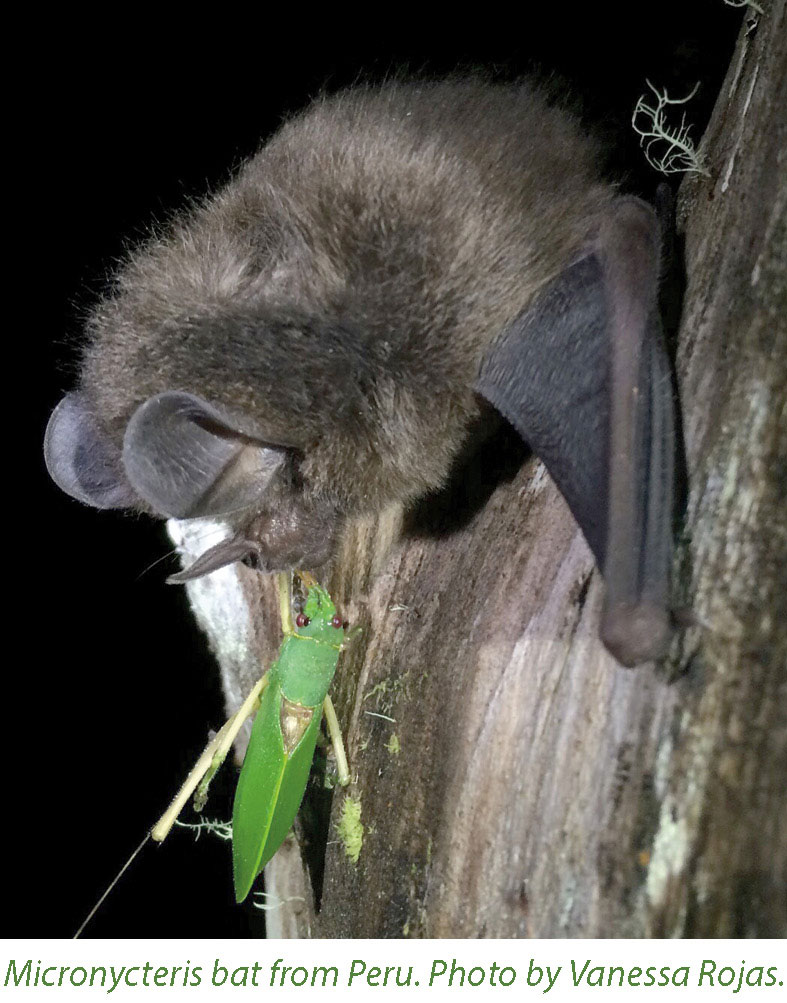 The largest species is the hoary bat (Lasiurus cinereus), clocking in at around 30 grams for an adult female, and the smallest is the tricolored bat (Perimyotis subflavus), averaging just five grams – that’s just five paperclips! Local bat diversity is highest in the southern portion of the state, where karst features and forests abound.
The largest species is the hoary bat (Lasiurus cinereus), clocking in at around 30 grams for an adult female, and the smallest is the tricolored bat (Perimyotis subflavus), averaging just five grams – that’s just five paperclips! Local bat diversity is highest in the southern portion of the state, where karst features and forests abound.
Do you have bats on your property? Likely so, but they may not be obvious to you. Go outside about ten minutes past official sunset on a warm summer night and you might be lucky enough to see bats swooping around as they chase bugs under the trees in your yard or coming down for a drink from a pond. Many folks tell me they see fewer bats in the night sky than they did when they were kids and there is indeed evidence of population declines in many of Indiana’s bat species due to disease, habitat loss and degradation, roost disturbances, and collisions with wind turbines. Three of Indiana’s bats are federally endangered, and another is a candidate for listing.
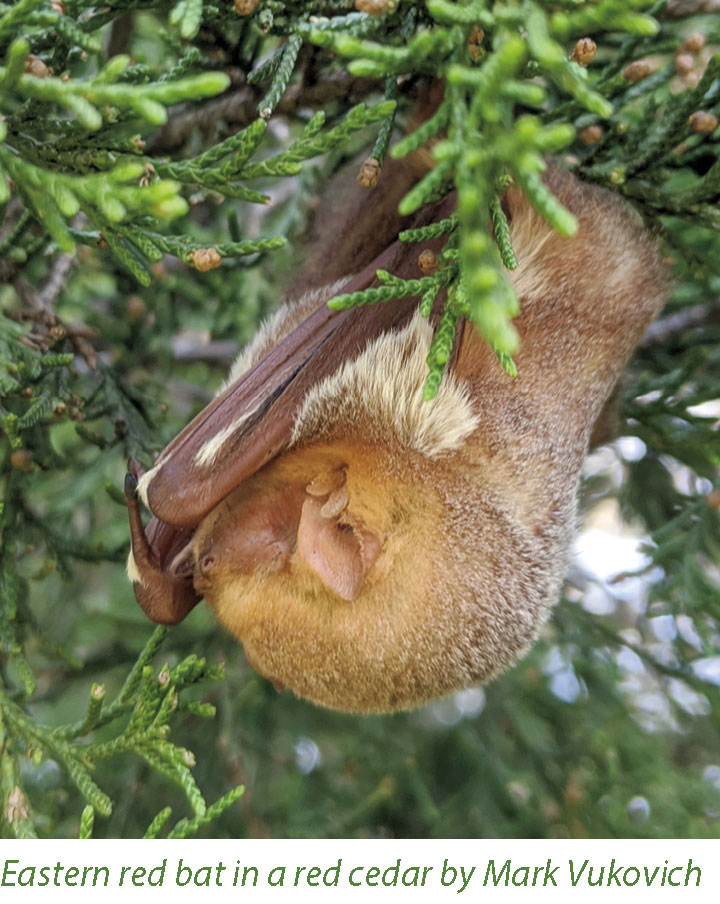 Forests are essential habitat for bats worldwide and in Indiana. From late March to late October, most bats in Indiana spend their days roosting in trees. Tree-roosting bats can be divided into foliage dwellers, like the eastern red bat (Lasiurus borealis) and the tricolored bat, and the cavity or crevice dwellers, like the endangered northern long-eared bat (Myotis septentrionalis) and Indiana bat (Myotis sodalis). Favored roosts are large, solar-exposed trees that provide warm temperatures for pup development and rearing, which happens from about May to August each year. Some trees may host tens to hundreds of females in a “maternity colony.” Bats sometimes shift to shaded trees below the canopy, roosting in small groups or singly. Even bats that roost among leaves are faithful to their summer roosting areas, returning year after year to the same trees or patches of woods.
Forests are essential habitat for bats worldwide and in Indiana. From late March to late October, most bats in Indiana spend their days roosting in trees. Tree-roosting bats can be divided into foliage dwellers, like the eastern red bat (Lasiurus borealis) and the tricolored bat, and the cavity or crevice dwellers, like the endangered northern long-eared bat (Myotis septentrionalis) and Indiana bat (Myotis sodalis). Favored roosts are large, solar-exposed trees that provide warm temperatures for pup development and rearing, which happens from about May to August each year. Some trees may host tens to hundreds of females in a “maternity colony.” Bats sometimes shift to shaded trees below the canopy, roosting in small groups or singly. Even bats that roost among leaves are faithful to their summer roosting areas, returning year after year to the same trees or patches of woods.
Look around your woodland for the trees that are valuable to bats. How will you know? Large-diameter trees (>1 foot across the trunk) are favored as roosts, particularly dead or damaged trees that offer big patches of sloughing bark on the main trunk or a cavity in the trunk or a branch, or all of the above. Foliage dwellers will tuck inside clumps of leaves (live or dead) of live trees. When choosing a roost, bats aren’t particular about tree species so much as tree structure. 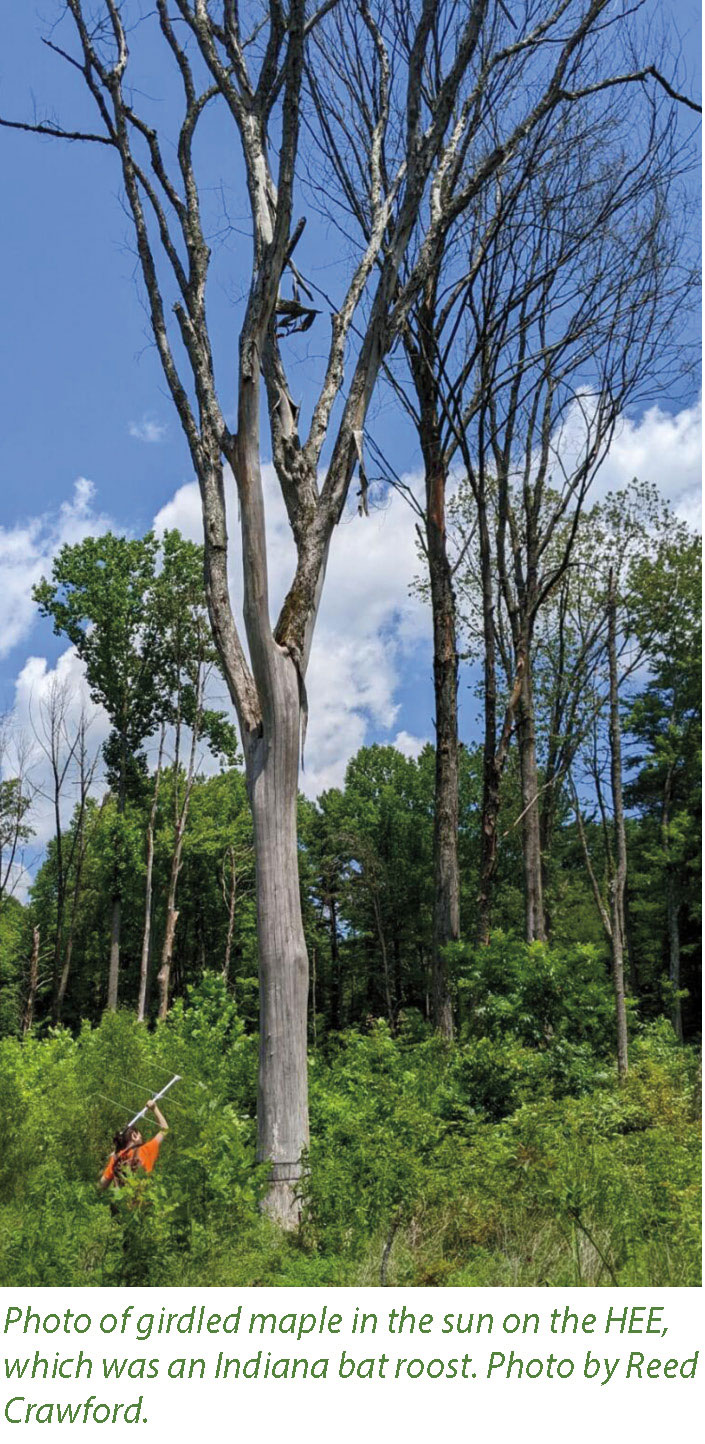 While oaks and hickories are always desirable, bats will take advantage of flushes of dead trees that arise due to disturbances, like the recent influx of ash snags because of the intrusion of the emerald ash borer into Hoosier forests. Even fast-growing poplar, maple, and cottonwood trees can be desirable roosts for bats.
While oaks and hickories are always desirable, bats will take advantage of flushes of dead trees that arise due to disturbances, like the recent influx of ash snags because of the intrusion of the emerald ash borer into Hoosier forests. Even fast-growing poplar, maple, and cottonwood trees can be desirable roosts for bats.
Because large trees and dead trees are essential for many bats, it’s important to protect some large trees with the unique nooks and crannies bats favor. Because most of Indiana’s forests were cut over in the past 150 years, there aren’t many really big trees left for bats to use. Dead trees are important habitat for several imperiled bat species, so if you plan to remove dead trees from your property the optimal time to do so is when bats are hibernating, which is from about November to late March. If you conduct a harvest during the warmer months, I recommend safeguarding dead trees, even leaving a patch of live trees around them to buffer them from treefall and the wind that will whip through newly open woods.
Understanding the effects of forest management on bats has been a focal area of my team’s research for over 20 years. One project I’ve been lucky to be involved in is the Hardwood Ecosystem Experiment (“HEE”; www.heeforeststudy.org) on Morgan-Monroe and Yellowwood state forests in southern Indiana. Capturing bats and tracking them to their roosting and foraging sites, we’ve learned how bats respond to even-aged and uneven-aged management techniques implemented by the Indiana Department of Natural Resources Division of Forestry. In general, we’ve shown that even endangered bats are coexisting with timber management, selectively roosting near patch cuts and logging roads, and foraging near patch cuts, clear cuts, thinned stands, roads, and ponds. In the mature but still relatively young state forest land where we work, small openings are desirable for bats because they allow sunlight to reach roost trees and give bats space to maneuver when zipping around searching for prey. With a better understanding of how bats respond to management, we can craft policies for forest management that are also conducive to protection of bats and their essential habitat.
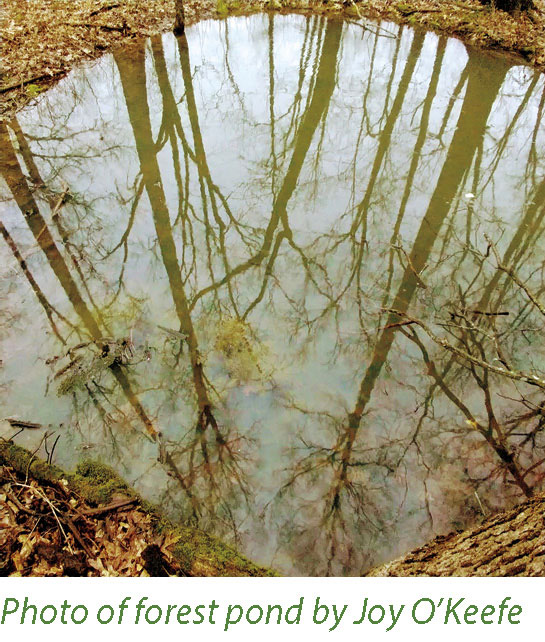 While my graduate students and I have been deliberately tackling questions about forest management and bats over the past 20 years, always in the back of my head was this question: if forests are important to bats, are bats important to forests? Surely the answer was yes, but we had essentially no data to assert this as a fact.
While my graduate students and I have been deliberately tackling questions about forest management and bats over the past 20 years, always in the back of my head was this question: if forests are important to bats, are bats important to forests? Surely the answer was yes, but we had essentially no data to assert this as a fact.
One “simple” way to address this question is to figure out what bats are eating. Historically this was done through microscopic analysis of dried bat guano pellets, which bats conveniently leave in our holding bags when we capture them. However, I entered this field at a time when metagenomics technology was emerging. Submitting samples of DNA we extracted from those guano pellets to be processed by powerful sequencing instruments, we can identify and tabulate the DNA fragments from residual bits of prey left in the guano. While we’re limited to identifying organisms with known DNA sequences stored in a common database, there are thousands of those sequences available and the database is always growing. This metagenomic approach has become the norm for most animal diet studies and yields some amazing information.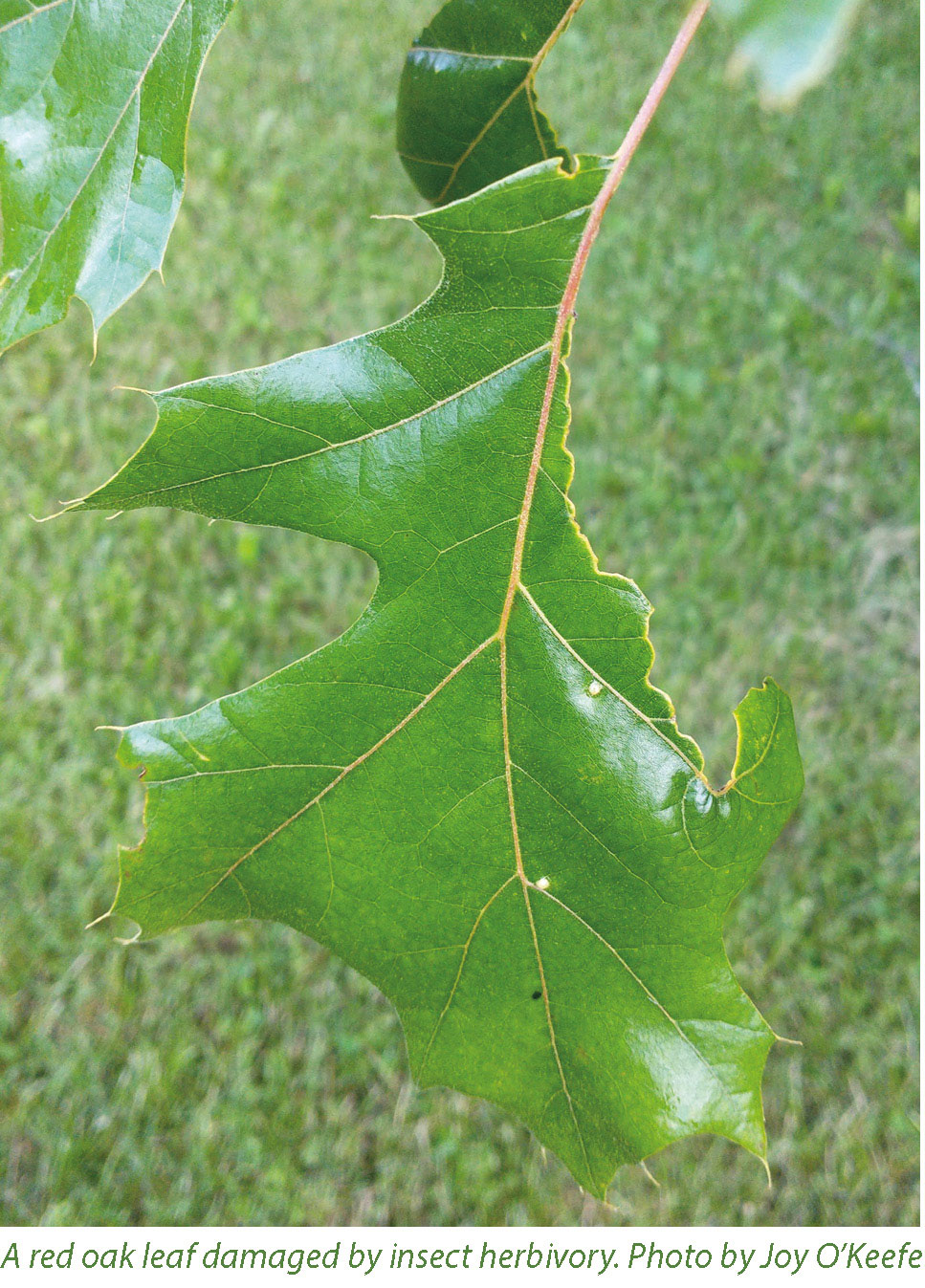
For example, my student Tim Divoll identified more than 500 prey items in the diets of endangered Indiana and northern long-eared bats foraging over Indiana’s forests. The prey consumed by the most individuals for both bat species were two oak-feeding moths (Chionodes pereyra and Perimede erransella) and a leafhopper (Gyponana brevita). Other frequently consumed prey included large forest moths (Catocala micronympha and Malacosoma americanum), and a large wood cockroach (Parcoblatta uhleriana), mosquitoes (Aedes vexans), and beetles (Dendroides canadensis and Ptilodactyla serricollis). The sequencer detected many agricultural and forest pest species detected, such as leafhoppers (Cicadellidae), leaf-rolling and vegetation-boring moths (Torticidae and Pyralidae), fruit flies (Drosophilidae), and weevils (Curculionidae). Tim identified at least 314 pests that either damage vegetation or transmit disease.
Noting that bats were consuming such a variety of forest pests, we conceived a study that would become a cornerstone of student Lizz Beilke’s PhD work. Working on the HEE, for three summers Lizz and her crew set up 6-7 pairs of plots each year, each with a control with no net and a bat-excluded plot for which the net was closed at night and opened during the day. This allowed birds but not bats access to the treatment plots. Lizz monitored oak and hickory seedlings in each plot, measuring insect density and leaf area at the beginning and end of the summer. This study showed that plots from which bats were excluded suffered five times more defoliation compared to control plots. And oaks were three times more affected by bat exclusion than hickories. As I’d hoped, Lizz’s work showed that bats are benefiting forests by suppressing pests that feed on ecologically important trees when they’re in the sapling stage.
I’m eager to apply more developing technology to the study of bats in Indiana’s forests. I’m guessing we will discover more ways that bats are benefiting forests and unique behaviors of bats in managed forests. By showing that a healthy bat population is an important component of a healthy forest, I hope I’ve convinced you to keep an eye out for bats and to safeguard the places and conditions they need to thrive in our forests.
Joy O’Keefe is an Assistant Professor and Wildlife Extension Specialist with the Natural Resources and Environmental Sciences Department at the University of Illinois Urbana Champaign.
